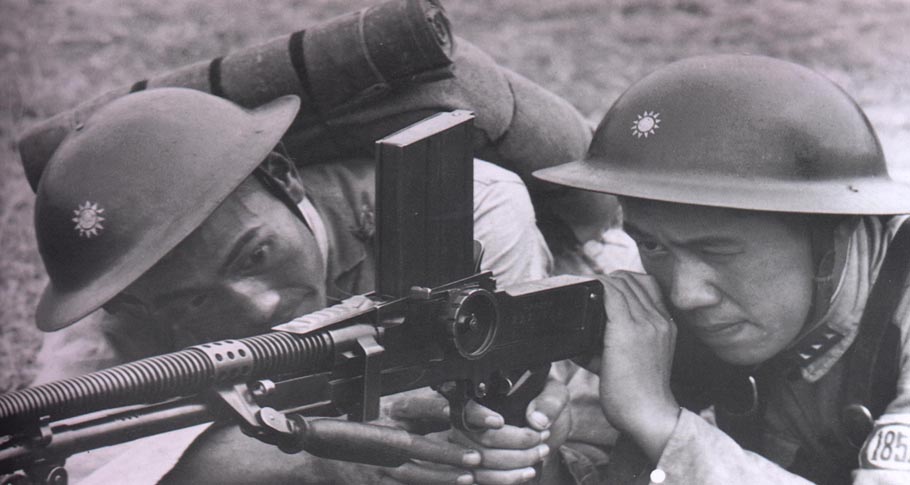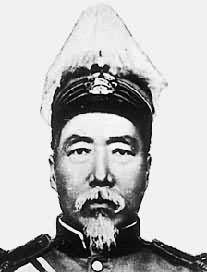|
Battle Of Tutung
The Battle of Tutong () of 1934 occurred when Gen. Ma Zhongying's Hui people, Chinese Muslim 36th Division (National Revolutionary Army), 36th Division was attacked by the Soviet Red Army on the banks of the frozen Tutung River. The battle took place over several days, and Soviet bombers used mustard gas. At one point the Chinese Muslim troops dressed up in sheepskins for camouflage in the snow, and stormed Soviet machine-gun posts with curved swords at a short range and defeated a Soviet pincer attack. Casualties were getting heavy on both sides before Ma Zhongying ordered a retreat. References Conflicts in 1934 1934 in China 1934 in the Soviet Union China–Soviet Union relations Military operations involving chemical weapons Wars involving the Soviet Union Military history of the Soviet Union Military history of the Republic of China (1912–1949) Xinjiang Wars Battles involving the Soviet Union Soviet chemical weapons program {{Russia-hist-stub ... [...More Info...] [...Related Items...] OR: [Wikipedia] [Google] [Baidu] |
1934 In China
Events from the year 1934 in China. Incumbents *President: Lin Sen *Premier: Wang Jingwei * Vice Premier: Kung Hsiang-hsi Events *April 10 - Fifth Encirclement Campaign against Jiangxi Soviet: Nationalists begin attack on Communist stronghold of Guangchang. *April 19 - Communist launch failed attack on Nationalists at Daluoshan. Communist strongholds at Ganzhu and Yanfuzhang taken by Nationalists. *April 27 - Nationalists capture Guangchang, inflicting 5,500 casualties on the Communists. *October - Start of Long March Births * January 1 – Mona Fong, Hong Kong film producer and manager (d. 2017) * March 10 – Fou Ts'ong, pianist (d. 2020) * July 17 – Lucio Tan, Chinese-Filipino billionaire businessman, educator Deaths *September 14 - Wang Zhanyuan *November 13 - Shi Liangcai Shi Liangcai () (January 2, 1880 – November 13, 1934) was a Chinese journalist best known for his ownership of '' Shen Bao'' and for his murder at the hands of Chiang Kai-shek's henc ... [...More Info...] [...Related Items...] OR: [Wikipedia] [Google] [Baidu] |
Xinjiang Wars
The Xinjiang Wars () were a series of armed conflicts which took place within Xinjiang in the Republic of China during the Warlord Era and Chinese Civil War. The wars also played an important role in the East Turkestan independence movement. Major conflicts * Kumul Rebellion (1931–1934) * Soviet invasion of Xinjiang (1934) * Charkhlik revolt (1935) * Islamic rebellion in Xinjiang (1937) * Ili Rebellion (1944–1949) Battles *Battle of Aksu (1933) *Battle of Sekes Tash * Battle of Kashgar (1933) *Battle of Toksun Incidents *Kirghiz rebellion See also *Qinghai–Tibet War The Qinghai–Tibet War or the Tsinghai–Tibet War was a conflict that took place during the Sino-Tibetan War. A rebellion led by the 13th Dalai Lama, Dalai Lama with British support wanted to expand the original conflict taking place between t ... * Sino-Tibetan War History of Xinjiang Wars involving the Republic of China 1930s conflicts 1930s in China Islam in China Military history ... [...More Info...] [...Related Items...] OR: [Wikipedia] [Google] [Baidu] |
Military History Of The Republic Of China (1912–1949)
The Republic of China Armed Forces (ROC Armed Forces) are the armed forces of the Republic of China (ROC), once based in mainland China and currently in its remaining jurisdictions which include the islands of Taiwan, Penghu, Kinmen, Matsu, and other smaller ROC-controlled islands such as Taiping Island in the South China Sea. They consist of the Army, Navy (including the Marine Corps), Air Force and Military Police Force. The military is under the civilian control of the Ministry of National Defense, a cabinet-level agency overseen by the Legislative Yuan. It was previously named the National Revolutionary Army (NRA) before being renamed as the Republic of China Armed Forces in 1947 due to the implementation of the newly promulgated Constitution of the Republic of China. It was also historically referred as the Chinese National Armed Forces (CNAF) prior to the establishment of the People's Republic of China on the Chinese mainland and the gradual loss of internationa ... [...More Info...] [...Related Items...] OR: [Wikipedia] [Google] [Baidu] |
Military History Of The Soviet Union
The military history of the Soviet Union began in the days following the 1917 October Revolution that brought the Bolsheviks to power. In 1918 the new government formed the Red Army, which then defeated its various internal enemies in the Russian Civil War of 1917–22. The years 1918–21 saw defeats for the Red Army in the Polish–Soviet War (1919–21) and in independence wars for Estonian War of Independence, Estonia (1918–20), Latvian War of Independence, Latvia (1918–20) and Lithuanian Wars of Independence, Lithuania (1918–19). The Red Army Winter War, invaded Finland (November 1939); fought the Battles of Khalkhin Gol of May–September 1939 (together with its ally Mongolia) against Empire of Japan, Japan and its client state Manchukuo; it was deployed when the Soviet Union, in Molotov–Ribbentrop pact, agreement with Nazi Germany, took part in the invasion of Second Polish Republic, Poland in September 1939, and occupied the Baltic States (June 1940), Bessarabia (Jun ... [...More Info...] [...Related Items...] OR: [Wikipedia] [Google] [Baidu] |
Wars Involving The Soviet Union
War is an intense armed conflict between states, governments, societies, or paramilitary groups such as mercenaries, insurgents, and militias. It is generally characterized by extreme violence, destruction, and mortality, using regular or irregular military forces. Warfare refers to the common activities and characteristics of types of war, or of wars in general. Total war is warfare that is not restricted to purely legitimate military targets, and can result in massive civilian or other non-combatant suffering and casualties. While some war studies scholars consider war a universal and ancestral aspect of human nature, others argue it is a result of specific socio-cultural, economic or ecological circumstances. Etymology The English word ''war'' derives from the 11th-century Old English words ''wyrre'' and ''werre'', from Old French ''werre'' (also ''guerre'' as in modern French), in turn from the Frankish *''werra'', ultimately deriving from the Proto-Germanic *''we ... [...More Info...] [...Related Items...] OR: [Wikipedia] [Google] [Baidu] |
Military Operations Involving Chemical Weapons
A military, also known collectively as armed forces, is a heavily armed, highly organized force primarily intended for warfare. It is typically authorized and maintained by a sovereign state, with its members identifiable by their distinct military uniform. It may consist of one or more military branches such as an army, navy, air force, space force, marines, or coast guard. The main task of the military is usually defined as defence of the state and its interests against external armed threats. In broad usage, the terms ''armed forces'' and ''military'' are often treated as synonymous, although in technical usage a distinction is sometimes made in which a country's armed forces may include both its military and other paramilitary forces. There are various forms of irregular military forces, not belonging to a recognized state; though they share many attributes with regular military forces, they are less often referred to as simply ''military''. A nation's milit ... [...More Info...] [...Related Items...] OR: [Wikipedia] [Google] [Baidu] |
China–Soviet Union Relations
SinoSoviet relations (; russian: Советско-китайские отношения, ''Sovetsko-kitayskiye otnosheniya''), or China–Soviet Union relations, refers to the diplomatic relationship between China (both the Republic of China (1912–49), Chinese Republic of 1912–49 and its successor, the People's Republic of China) and the various forms of Petrograd Soviet, Soviet Power which emerged from the Russian Revolution of 1917 to 1991, when the Soviet Union ceased to exist. Country comparison Russian Civil War and Mongolia The Beiyang government in north China joined the Allied intervention in the Russian Civil War, sending forces to Siberian Intervention, Siberia and North Russia Campaign, North Russia beginning in 1918. Mongolia and Tuva became contested territories. After being Occupation of Mongolia, occupied by the Chinese General Xu Shuzheng in 1919, they came under the sway of the White movement, Russian White Guard General turned independent warlord, Roman Ung ... [...More Info...] [...Related Items...] OR: [Wikipedia] [Google] [Baidu] |
1934 In The Soviet Union
The following lists events that happened during 1934 in the Union of Soviet Socialist Republics. Incumbents * General Secretary of the Communist Party of the Soviet Union – Joseph Stalin * Chairman of the Central Executive Committee of the Congress of Soviets – Mikhail Kalinin * Chairman of the Council of People's Commissars of the Soviet Union – Vyacheslav Molotov Events * 26 Jan–10 Feb – 17th Congress of the All-Union Communist Party (Bolsheviks) * 18 September – Soviet Union joins the League of Nations as a permanent Board member Undated * Plans for the new T-34 tank are first drawn up * Second Five Year plan underway Publications Births * 7 January – Viktor Pavlovich Potapov, military officer (d. 2021) * 9 March – Yuri Gagarin, first man in space (d. 1968) * 7 April – Lev Anninsky, Russian literary critic, historian and screenwriter (d. 2019) * 8 May – Anastasiya Kobzarenko, librarian * 29 August – Gennady Kazmin, politician (d. 2018) * 4 Septem ... [...More Info...] [...Related Items...] OR: [Wikipedia] [Google] [Baidu] |
Conflicts In 1934
Conflict may refer to: Arts, entertainment, and media Films * ''Conflict'' (1921 film), an American silent film directed by Stuart Paton * ''Conflict'' (1936 film), an American boxing film starring John Wayne * ''Conflict'' (1937 film), a Swedish drama film directed by Per-Axel Branner * ''Conflict'' (1938 film), a French drama film directed by Léonide Moguy * ''Conflict'' (1945 film), an American suspense film starring Humphrey Bogart * ''Catholics: A Fable'' (1973 film), or ''The Conflict'', a film starring Martin Sheen * ''Judith'' (1966 film) or ''Conflict'', a film starring Sophia Loren * ''Samar'' (1999 film) or ''Conflict'', a 1999 Indian film by Shyam Benegal Games * ''Conflict'' (series), a 2002–2008 series of war games for the PS2, Xbox, and PC * ''Conflict'' (video game), a 1989 Nintendo Entertainment System war game * '' Conflict: Middle East Political Simulator'', a 1990 strategy computer game Literature and periodicals * ''Conflict'' (novel) ... [...More Info...] [...Related Items...] OR: [Wikipedia] [Google] [Baidu] |
Xinjiang Province, Republic Of China
Xinjiang Province () or Sinkiang Province was a province of the Republic of China. First set up as a province in 1884 by the Qing dynasty, it was replaced in 1955 by the Xinjiang Uygur Autonomous Region of the People's Republic of China. The original provincial government was relocated to Taipei as the Sinkiang Provincial Government Office (新疆省政府辦事處) until its dissolution in 1992. Administration The province inherited the borders of the Qing dynasty province, bordering Kansu, Tsinghai, the Mongol Area, Tibet Area and the countries Soviet Union, Afghanistan, India and Pakistan. The claimed boundaries of the province included all of today's Xinjiang and parts of Mongolia, Tajikistan, Afghanistan and Pakistan. History In 1912, the Qing dynasty was replaced by the Republic of China. Yuan Dahua, the last Qing governor of Xinjiang, fled. One of his subordinates, Yang Zengxin, took control of the province and acceded in name to the Republic of China in March ... [...More Info...] [...Related Items...] OR: [Wikipedia] [Google] [Baidu] |
Mustard Gas
Mustard gas or sulfur mustard is a chemical compound belonging to a family of cytotoxic and blister agents known as mustard agents. The name ''mustard gas'' is technically incorrect: the substance, when dispersed, is often not actually a gas, but is instead in the form of a fine mist of liquid droplets.https://www.acs.org/content/dam/acsorg/education/resources/highschool/chemmatters/gc-mustard-gas-personal-safety-and-natl-security.pdf Mustard gases form blisters on exposed skin and in the lungs, often resulting in prolonged illness ending in death. The active ingredient in typical mustard gas is the organosulfur compound bis(2-chloroethyl) sulfide. In the wider sense, compounds with the structural element are known as ''sulfur mustards'' and ''nitrogen mustards'', respectively. Such compounds are potent alkylating agents, which can interfere with several biological processes. History as chemical weapons As a chemical weapon, mustard gas was first used in World War I, and has ... [...More Info...] [...Related Items...] OR: [Wikipedia] [Google] [Baidu] |





